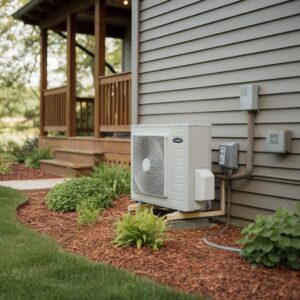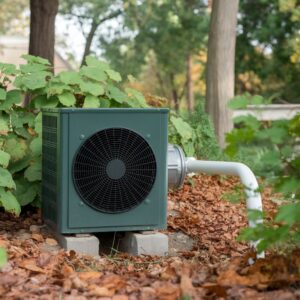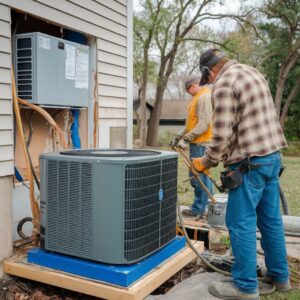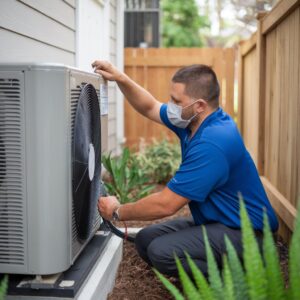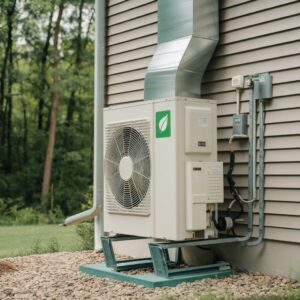Installing new water lines can be a daunting task for many homeowners. Whether you’re adding a line for a new appliance or replacing an outdated main supply, proper planning and technical know-how are essential. DNA Plumbing and Heating specializes in guiding customers through safe, code-compliant methods. By learning how to install a water line correctly, you’ll ensure reliable water flow, protect your investment, and prevent potential hazards in your home.
From selecting pipe materials for plumbing to ensuring secure connections, each step matters. Missteps could lead to leaks, water damage, and costly repairs down the road. Fortunately, you can minimize risks with careful preparation, the right tools for plumbing installation, and a thorough grasp of building codes. Whether you’re curious about how to install new water lines, flexible lines, or a main water line to your house, this guide explains it all—backed by insights from experienced Local Water Line Specialists.
Planning Your Water Line Installation
The first step in how to install a water line is to plan thoroughly. Begin by locating your property’s main shutoff valve and confirming local regulations about trenching or installing new lines. Assess your pipe condition and material if you’re connecting to an existing system. Consider local frost line depths for burying pipes and ensure you have the correct permits. By organizing these essentials, you’ll save time, avoid fines, and stay code-compliant.
Next, gather the right tools for plumbing installation, including measuring tape, pipe cutters, wrenches, soldering equipment (if you plan on joining copper pipes), and an assortment of fittings. Additionally, consider installing shutoff valves and regulators to manage water pressure and create safer connections. DNA Plumbing and Heating recommends verifying any unique state or municipal requirements before breaking ground, helping you plan a seamless and legally compliant project.
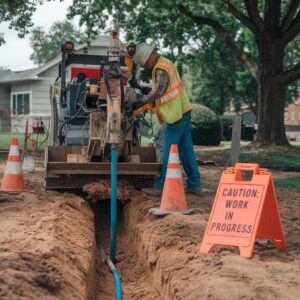
Choosing the Right Pipe Material
One major decision involves selecting pipe materials for plumbing. Copper pipes are durable, corrosion-resistant, and a common choice for main water line installations. However, PEX or other flexible plastic lines offer simpler connections, especially when learning how to install flexible water lines. PVC is another affordable option often used in cold-water applications. Ultimately, the correct material depends on your budget, local codes, and distribution needs—factors DNA Plumbing and Heating evaluates on every project.
Mixing different pipe materials can be tricky. If you’re adding a water line to existing plumbing, you may connect copper to PEX or PVC with transitional fittings designed for such purposes. Always verify compatibility with temperature, pressure ratings, and local codes. By consulting licensed professionals for brand-neutral advice, you’ll avoid leaks, corrosion, and other issues down the road, ensuring a smooth water line installation that stands the test of time.
Measuring and Marking
Measuring pipes for plumbing installation is crucial for an efficient layout. Use a tape measure to map out your route from the main supply to all intended fixtures. Mark where you’ll cut or bend the pipe to navigate corners and obstacles. If you’re learning how to install the main water line to the house, accurately measuring the distance from the street or well to your indoor distribution system prevents costly shortfalls or wasteful overpurchasing.
Take into account any elevation changes—such as slopes or basement entries—that could affect drainage or line pressure. Mark all shutoff valve placement points, ensuring they’re accessible for future maintenance. DNA Plumbing and Heating emphasizes clarity in your measurements: well-planned routes simplify installation, reduce the need for awkward bends, and help maintain consistent water pressure throughout your home.
Excavating and Site Preparation
If you’re installing an underground line, careful excavation is key. Check with utility companies to locate buried lines before digging, following local US guidelines on safe digging practices. Plan for an extra room around the pipe path to allow for easy movement during placement. For how to install a water main line, the trench depth should meet local frost codes, typically below the freeze level to maintain a steady water supply even in winter.
Ensure you’re using proper digging tools, such as a trenching shovel or power trencher for larger jobs. Keep the trench floor at a level as possible to avoid pipe sagging and subsequent water pressure issues. If the soil is rocky, consider adding a gravel or sand bed for pipe protection. DNA Plumbing and Heating stresses that thorough site preparation can save on repairs and water damage in the long run. For homeowners looking to avoid major excavation altogether, Modern Trenchless Water Line Replacement offers a less disruptive alternative.
Cutting and Fitting Pipes
Accurate cutting and fitting are central to a leak-free system. Whether it’s copper, PEX, or PVC, follow manufacturer guidelines for clean cuts and secure joins. If you’re installing flexible lines, use a specialized cutter to produce smooth edges. For rigid pipes, a circular or reciprocating saw with the correct blade can help. Always measure twice and cut once, ensuring each segment aligns with your pre-mapped layout.
When connecting different pipe materials, use the appropriate transition fittings to prevent chemical corrosion or pressure failure. Soldering copper pipes correctly involves cleaning the pipe ends, applying flux, heating the joint, and letting the melted solder flow into the gap. PVC and PEX often connect with solvent welds or crimp rings. DNA Plumbing and Heating trains technicians to confirm every join is snug and meets local building code requirements for reliable water line performance.
Installing Shutoff Valves and Pressure Regulators
A key step in how to install new water lines involves integrating shutoff valves near the main entry point and at major fixtures. These valves give homeowners control over water flow during repairs or emergencies. Pressure regulators help maintain steady flow, minimizing strain on your pipes and fixtures. Proper placement and correct sizing ensure smooth operations, reduce water hammer effects, and help protect your plumbing system from damage.
Align each valve so it’s easy to access and operate. If you’re installing a main water line to the house, consider placing a shutoff inside your basement or utility room—away from temperature extremes. DNA Plumbing and Heating advises US homeowners to confirm local regulations for valve placement, as some states have specific guidelines to prevent backflow problems or ensure ease of maintenance.
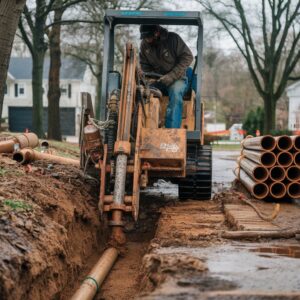
Testing for Leaks
Once all pipes and valves are in place, testing water lines for leaks is essential. Turn on the main water supply gradually while keeping an eye on pressure gauges, fittings, and any newly soldered or connected joints. Watch for drips or signs of moisture forming around the pipe surfaces. If you observe a leak, promptly shut off the water supply, repair the faulty segment, and test again.
Professional plumbers often use air testing before introducing water to detect small leaks. This approach can simplify repairs without creating a watery mess. DNA Plumbing and Heating recommends performing multiple checks over the course of a few hours to ensure subtle leaks don’t go unnoticed. A thorough inspection not only safeguards your home from water damage but also confirms your installation meets US plumbing code standards for system integrity.
Backfilling and Site Restoration
After you’ve confirmed leak-free performance, carefully backfill the trench or any access holes. Use clean, rock-free fill to protect the pipes from shifting or damage. Compact the soil in stages to reduce settling, layering it around the newly installed water line. Avoid rushing this step: uneven backfill can strain the pipes, leading to future problems. Proper backfilling ensures a stable foundation for driveways, sidewalks, or yard landscaping above.
Restore all removed sod, pavement, or landscaping surfaces to their original state. If you rework a lawn, consider placing fresh topsoil and reseeding the area for a neat finish. DNA Plumbing and Heating always leaves job sites clean and safe for homeowners. This careful approach protects your property’s appearance, boosts curb appeal, and minimizes the need for future excavation.
Code Compliance and Safety Tips
Throughout your entire project, respect state and local building codes designed to protect both your home and community infrastructure. These guidelines cover trench depth, pipe materials, joint methods, and more. Ignoring them could result in fines or compromised water quality. DNA Plumbing and Heating remains committed to upholding these regulations, ensuring your system not only functions optimally but also meets every legal obligation for safe water distribution.
For added safety, consider enrolling in a local plumbing workshop or consulting a trusted professional before making significant changes. Adequate personal protective equipment—like gloves, goggles, and sturdy footwear—can prevent injuries during the installation. Keep an accessible fire extinguisher if you’re soldering copper fittings. By blending caution, knowledge, and the right tools, you’ll master how to install a water line to house systems without risking code violations or personal harm.
Troubleshooting Common Issues
Occasionally, homeowners face challenges—like unexpected obstructions, tricky pipe routing, or pressure fluctuations—when installing a new water line. If you notice frequent leaks in one area, check for misaligned fittings or improper sealing materials. Rattling sounds might signal loose supports or improper pressure regulator settings. When these problems arise, stopping work to diagnose the root cause can save you from extensive repairs and frustration down the road.
If obstacles continue, reach out to an experienced service like DNA Plumbing and Heating for professional guidance. We can identify hidden issues—like corroded sections or poorly graded lines—and correct them immediately. By drawing on years of expertise, you’ll enjoy a streamlined installation with minimal guesswork. Ultimately, addressing problems early ensures you’ll have a durable, efficient water line that won’t require constant upkeep.
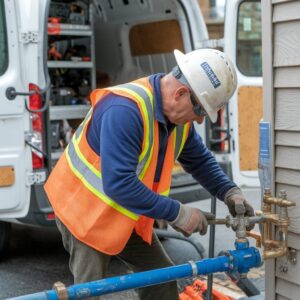
When to Call DNA Plumbing and Heating
Installing a water line is a significant undertaking. If you’re feeling overwhelmed or aren’t comfortable with advanced tasks—such as soldering copper pipes correctly or connecting different pipe materials—it might be time to call in licensed professionals. DNA Plumbing and Heating services keep projects on schedule, adhere to US plumbing code compliance, and protect your home’s integrity. Our skilled team arrives fully equipped to manage complex installations, ensuring top-notch workmanship.
We take pride in planning water line installation from start to finish, focusing on proper permitting, best-fit materials, and robust leak testing. By trusting experts who handle how to install flexible water lines or how to install water main line tasks daily, you’ll gain peace of mind and a well-functioning system. Accessible for emergencies or scheduled installs, DNA Plumbing and Heating remains a trusted ally for US homeowners seeking quality and timely results.
Conclusion
Knowing how to install a water line empowers US homeowners to maintain better control over their plumbing systems. Whether you’re updating aging components or adding a new line, each step benefits from careful planning, code awareness, and precise execution.
If you run into complications or prefer professional assistance, DNA Plumbing and Heating stands ready to help. Count on our expertise, local compliance knowledge, and dependable service for every phase of installation. Our guidance on Pipe Types for Main Water Lines ensures you choose materials that last and perform optimally. Secure your home’s water supply today—reach out to our friendly team for a consultation.

